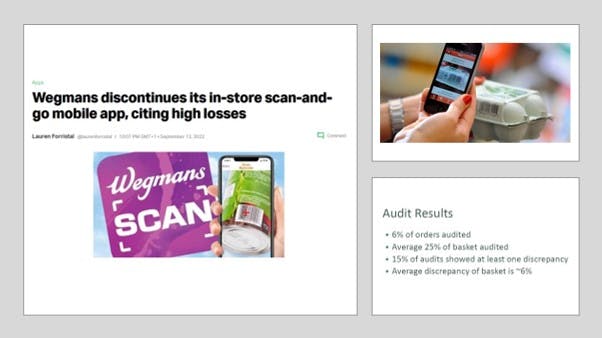Embracing the Evolution of Scan and Go: A Dive into Retail Loss Prevention
Categories:
Written by:
Colin Peacock
Embracing the Evolution of Scan and Go: A Dive into Retail Loss Prevention
In the dynamic landscape of retail, 'Scan and Go' technology is rapidly maturing, reshaping the shopping experience with retailers loss prevention strategies rapidly evolving to meet the changing levels of risk.
In previous ECR research, click here, Professor Beck identified that when whole baskets were audited, up to 43% of those baskets were found to have at least one error, Thus for every 1% of Scan and Go sales, there was an 11 basis points rise in shrink. For some retailers in the group, over 10% of all their transactions were now being processed via Scan & Go. This explains the need for action. and sense of urgency for change,
In our regular ‘Scan and Go’ expert only group meeting, each retailer (there are ten in the group from USA, Europe and Australia) provided their latest learnings and insights on the advancements they are implementing to help this proposition grow AND become more profitable, with a focus on exploring the latest thinking on the algorithms, rules and principles that determine the targeting and frequency of service / accuracy checks.
The challenge for the loss prevention team is to find innovative ways to audit only those customers most at risk, in the least amount of time. In this meeting, we learnt about the move away from a trust level only approach, to a trust level PLUS approach that included an "in basket" risk assessment to determine who to audit. We also learnt about innovative ways to think about the partial audits, and the importance of the design and layout of the space used for auditing. Above all, we learnt that there were interesting variances and nuances in each retailers approach, this became the core source of learning.
For industry experts, retailers, and academics specialising in loss prevention, a recap video and edited transcript of this recap conversation (below) offers a deeper understanding of the current challenges and opportunities in leveraging Scan and Go technology effectively.
[Transcription edited for clarity]
Colin Peacock: Last week our expert group examined the trends and changes retailers are implementing to better control losses and conduct service checks or audits more efficiently, with minimal disruption to shoppers. It's a fascinating area.
Beck, Adrian (Prof.) Indeed, Scan and Go is maturing. In some retail markets, it's becoming more prevalent in terms of transaction volume. There are two systems: one where the retailer provides a scanning device, and another where consumers use their own mobile devices. Our 2018 study showed that losses can be significant due to the freedom and trust given to consumers to scan all items correctly, especially in complex and busy environments.
Colin Peacock: Your report indicated that for every 1% of sales through Scan and Go, there was an eleven basis point increase in shrinkage. That's quite significant.
Beck, Adrian (Prof.): Yes, and data suggests that up to 40-43% of transactions may have at least one error. It's a risky space, both due to malicious intent and non-malicious errors from customers multitasking in-store. Audits are a control method, but they're challenging to execute effectively. Retailers vary in how they select customers for audits and which items to check. The development of nuanced algorithms to identify likely errors is crucial to avoid false positives and maintain customer service.
Colin Peacock: Yes, and we heard about matching labour hours to the algorithm's recommendations for checks, which is intriguing. You've also emphasized the importance of random audits for accurate loss measurement. Why is that so vital?
Beck, Adrian (Prof.): Partial audits only capture a fraction of the errors compared to full random audits. Retailers need a mechanism for random audits to truly understand the extent of losses. This benchmarking can inform the effectiveness of partial audits. Some retailers are incorporating this, while others avoid it due to customer inconvenience, sacrificing valuable data.
Colin Peacock: There's a divergence in the language used in reports for store associates, with some focusing on accuracy and others on the number of fails found. Is this just retailer preference?
Beck, Adrian (Prof.): It's about performance measurement. If 40% of Scan and Go users are likely to err, staff performance can be gauged accordingly. The discrepancy between expected and actual error detection rates can highlight training or process issues. It's a balance between staff capability and algorithm effectiveness in identifying errors.
Colin Peacock: More data is becoming available. Some retailers offer incentives like vouchers for random checks. The percentage of shoppers audited and the failure rates vary, indicating potential gaps in error detection.
Beck, Adrian (Prof.): The number of items checked also varies widely. Some retailers check a fixed number, while others check a percentage, which can be as effective as a full audit. Interestingly, the most common items involved in scan errors are everyday items like milk and cucumbers, suggesting errors over theft. Retailers are discussing system glitches and advocating for scan-compliant products from manufacturers.
Colin Peacock: We've seen examples where common items causing errors could be addressed with manufacturers to improve scan compliance. We plan to reconvene in May to explore opportunities for ECR to compile a common list of problematic items and engage with vendors for solutions.
Beck, Adrian (Prof.): That's right. It's in everyone's interest to ensure accurate scanning for correct stock records and loss prevention. Cheers, Colin. Bye.
Next SCO Meeting - Nov 21st
In this meeting we will hear from retailers who have been looking at new ways to reduce the risk of loss at SCO from the PLU menu
CLICK TO REGISTERNov 9, 2023
Main office
ECR Community a.s.b.l
Upcoming Meetings
Join Our Mailing List
Subscribe© 2023 ECR Retails Loss. All Rights Reserved|Privacy Policy
